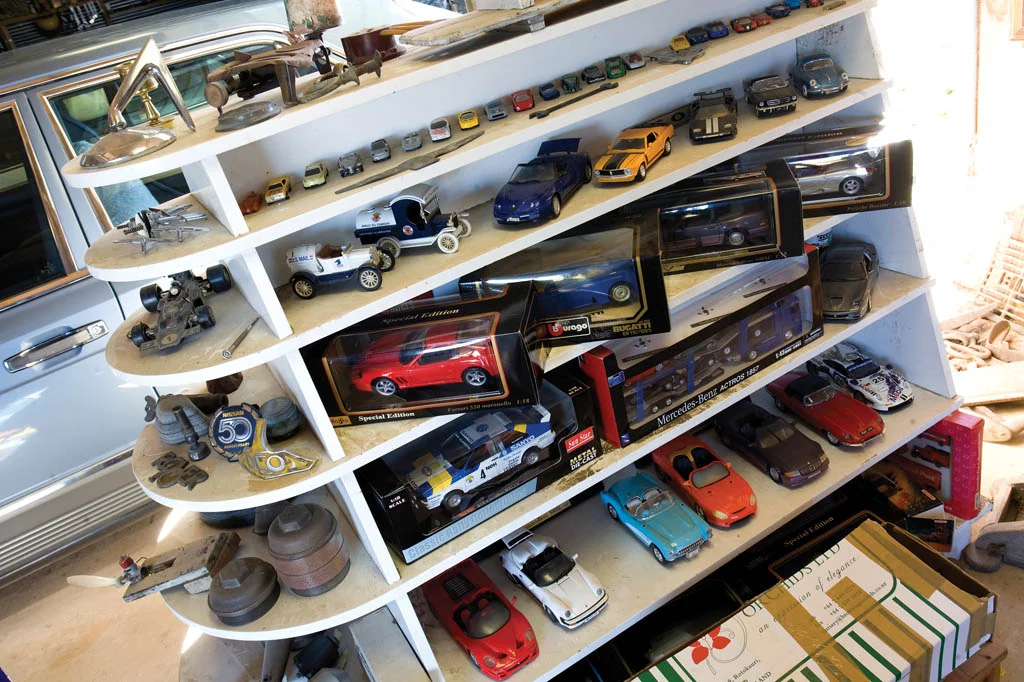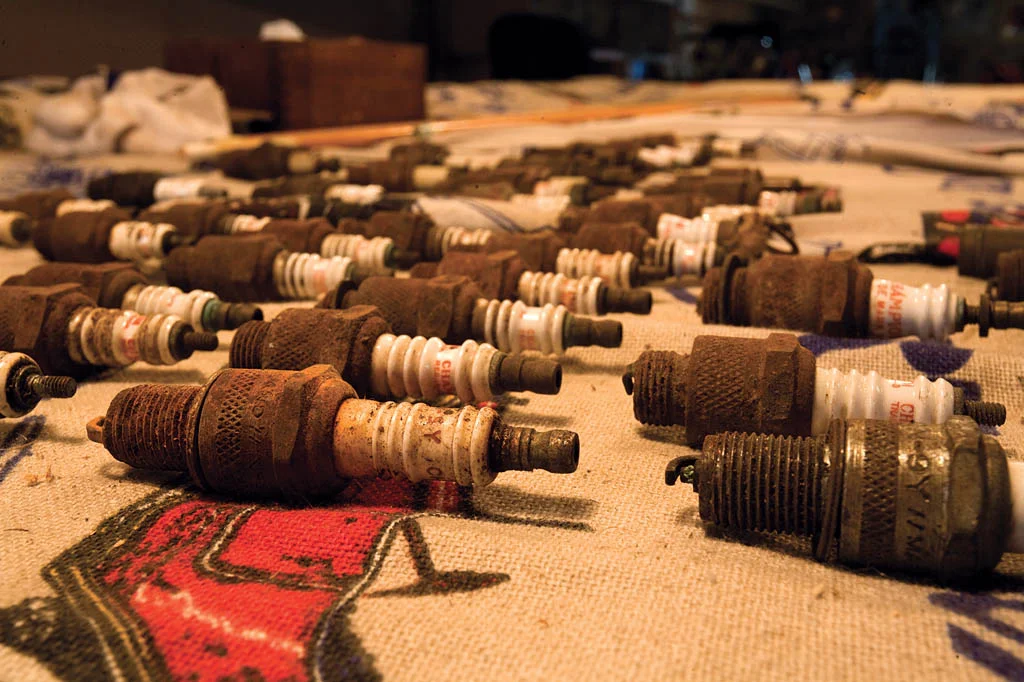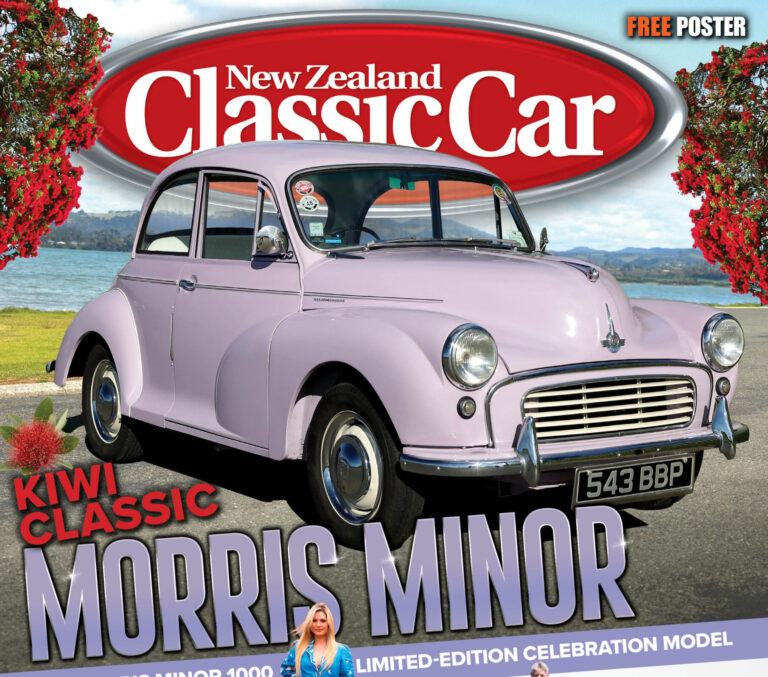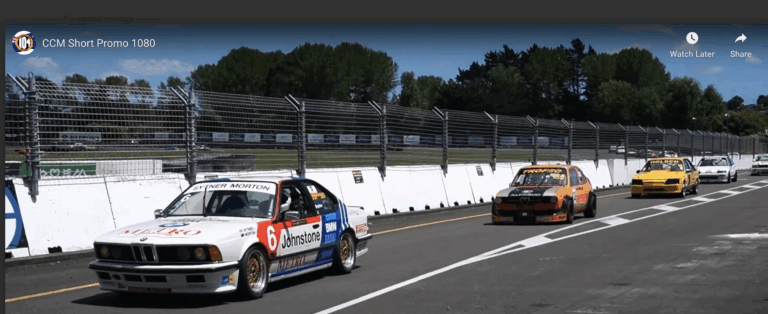data-animation-override>
“Published in New Zealand Classic Car Issue No. 213”

During our visit to Kaikoura, we met Bob Bell and checked out the veritable Aladdin’s cave that he calls his home shed
I’ve probably said it many times, but one of the great things about working on NZ Classic Car is not only the fine cars we get to see virtually on a daily basis, but the fantastic people we meet along the way who enjoy sharing their fabulous yarns with us about their hobby.
One such person is Kaikoura’s Bob Bell who, along with Kaikoura’s Pier Hotel owner, Steve Kirkpatrick, made our trip to the South Island not only possible but highly enjoyable.
Besides exploring Bob’s shed, he has a great, life-long passion for cars to share — one that stretches back almost five decades to the time when he travelled to Ardmore as a child with his father to watch the NZ Grand Prix. In fact, Bob has been a keen motorsport follower ever since, not missing too many racing events at our end of the world — he’s attended almost every Australian Grand Prix.
Losing count
Bob has, quite literally, lost count of all the cars that he has owned over the years — although he recalled that it started at the tender age of 14 with a Ford 8. He remembers towing it home with his father and, after several attempts to get it running, they decided to wreck it — which, as it turned out, was quite a profitable exercise as the pair picked up £30 on the deal.
This was also the catalyst for what would play an important part in Bob’s life — his shed. It was at around this time that Bob eventually commandeered the family garage, and ever since he has always owned his own shed — and we’re not talking your standard 6×6-metre job; every one of Bob’s houses has boasted a decent-sized garage.
By the time Bob had reached the age of 17 he decided to head over the ditch to live — he had already owned least a dozen cars, including a rare 1929 six-cylinder Chevrolet Roadster, three Model As, a couple of Austin specials, a Hudson Super 6, 1937 Tickford-bodied Rover drophead coupe — a car created specially for the 1937 London Motor Show — and a MkV Jaguar, the latter bought along with his father.
Unfortunately, Bob scuttled three telegraph poles in the Jaguar and, with the eventual insurance pay-out, his father bought a 1949 Ford Single Spinner. Bob eventually saved up enough money and bought his own MkV Jaguar.
Australian adventures
Bob lived in Australia for a while — he remembers that his first car over there was a Vauxhall Wyvern — but soon returned to New Zealand with his Australian wife. They didn’t stay here for long, and were soon packing their gear and heading off across the Tasman again.
Initially, Bob purchased a Toyota Land Cruiser and a six-metre caravan, in which the couple travelled around Australia for just over a year. With their wanderlust slaked, the pair finally settled in Sydney.
Once there, Bob built their first house — which obviously included a fairly substantial garage. This would eventually house an early 3.0-litre BMW, Jaguar XK150, Lancia Fulvia Rallye coupe, 1974 2.7 911 Porsche Carrera and a VB SL/E Commodore.
The Lancia came to a sticky end when it took on a bridge and came off second best! The XK150 was sold, only to be replaced by a brace of Mk2 Jaguars and a rare 1961 Lincoln four-door convertible. A BMW 633CSi was added along the way, as well as a partially restored 1961 Thunderbird convertible — both of which he still owns today. Bob recalls visiting a Sydney Motor Show in the ’80s, where he came across the newly released Mercedes 190 Cosworth on display. Bob was mighty impressed with this car and wanted to get a closer look, thinking that this could be the car for him one day. Dressed in only shorts, jandals and a T-shirt (well, it was summer) he was refused entry onto the stand, not being allowed to get anywhere close to the Mercedes. Bob then noticed a bright, shiny new BMW 633csi on the stand opposite — the rest you know.
During the mid-’90s, Bob and his second wife, Karen, travelled to Kenya to teach for six months after touring Great Britain and Europe in an old VW campervan. During that time, they adopted a 10-year-old Kenyan girl, Maureen. When they decided to return to Australia, the strict Australian immigration regulations imposed on them at the time meant that the easiest option was to return to New Zealand, and fight the Australian authorities from there in order to get Maureen into Australia.
That took around five weeks and, in the end, Maureen was only granted a five-year visa — if she left Australia during that period she would not be allowed to return. Bob and Karen decided to bring Maureen to New Zealand for three years, which would make her eligible for New Zealand residency.
Kaikoura Bound
Bob has fond memories of Kaikoura, often travelling over from Australia to attend classic race meetings and staying there. He and Karen had also spent time in Kaikoura over the years and decided to take Maureen to the South Island to see the snow, something she had never experienced before. During that trip, Bob and Karen purchased a spectacular piece of land in Kaikoura which they had noticed on a previous trip. They then went back to Australia to sell up, which actually took about a year due to the length of time it took to sell their house.
Bob never told anyone in Australia about their new plans, just to say that they were selling their house and building a new one — never mentioning that the new house would be built in New Zealand!
Bob also had to part with at least nine cars to lighten the load — including a rare 16-litre 1927 Le France fire-pumper. He was left with the Lincoln convertible, Thunderbird, BMW 633CSi coupe, and Alta Special vintage race-car, Porsche Carrera and a rare Benelli six-cylinder motorcycle.
And so, towards the end of 1999, Bob, Karen and Maureen arrived in New Zealand and set to work building their new home in Kaikoura. The first challenge was to erect a temporary building so they had a roof over their heads — this initial building would later become Karen’s art studio and gallery.
The cars were kept in containers before Bob got around to building his large shed. Everyone still laughs, recalling that Bob built the shed before the house — but Bob’s a man who clearly has his priorities set right. With the shed built and cars unpacked from the containers it was time to focus on the house — which, incidentally, is fabulous. Its French provincial theme allows for magnificent views of the surrounding mountains and sea from everywhere you look. Now called Homewood Hill, Bob and Karen offer it as a luxury B&B for tourists who really want to spoil themselves.
The Shed
Over the past few years since work on the house was completed, Bob has “sold a few and gained a few” as he puts it. During that time he sold his 1974 911 Porsche Carrera and Lincoln convertible, replacing them with another Mk2 Jaguar which has been built as a John Coombs Special; boasting triple carbs, cut-out wheel spats, louvered bonnet, manual gearbox with overdrive, XJ6 rack and pinion power steering and a Vicarage coil-sprung rear end.
The fully restored 1970 Morris Minor Traveller — also featured elsewhere in this magazine — is Karen’s daily driver, a car she prefers to drive rather than either of their two Range Rovers.
The unfinished Alfa classic racer, called the ‘Vault’ due to its Vauxhall running gear — and the amount of money tied up in it — sits alongside a Thunderbird convertible, the 633CSi and the Benelli motorcycle.
Bob’s 1961 Thunderbird has since been modified to include a late model Falcon rack and pinion steering, as the Australian RHD conversion was unacceptable for NZ compliance.
Unfortunately, Bob can’t help himself when it comes to swap meets and visiting other people’s shed and, over the years, he has collected a substantial array of all kinds of motoring paraphernalia — including an impressive
collection of old spark plugs. He’s even got a penny-farthing bicycle.
Wandering around the shed, time seemed to pass by quickly as virtually every item has its own unique little story which Bob is only too happy to share. Naturally, there have been other cars that have come and gone such as a Borgward Arabella coupe, a ’60s dirt-track racer, a couple of Morris Minors, a few Rover P6Bs and a Triumph 2500 which Bob couldn’t resist. Those cars have gone to make way for Bob and Karen’s
new plans.
Yes, the time has come for them to return to Australia. Maureen is now 21 and is building her own life in Auckland, so Bob and Karen have decided to head back over the ditch to be with family and friends. Although the decision was a hard one — which car to take and which to leave behind — the collection will follow them and will, no doubt, take pride of place in Bob’s next shed, wherever that may be.
Bob and Karen, we wish you well, you’ll be sorely missed among the Kaikoura classic car community.
Words: Ashley Webb Photos: Adam Croy

















